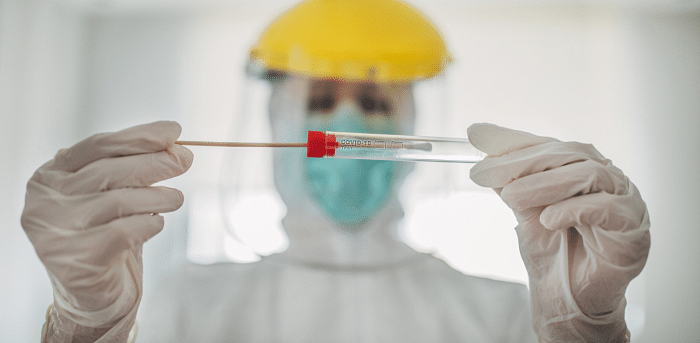
By Jassi Pannu and Jacob Swett
Modern humans have existed for over 200,000 years. A mere 500 years ago, daily life was strewn with infectious risk. Eating a meal was a risk, as was drinking a glass of water.
As we shifted to indoor city life, outbreaks and pandemics whipped through society with alarming regularity. At one point, major epidemics of plague were occurring approximately every 30 years in England, killing about one-fifth or more of London’s population each time. The black, golf-ball-size, pus-filled buboes caused by the culprit bacteria, Yersinia pestis, so terrified Queen Elizabeth I that she escaped the city for Windsor with her court and ordered anyone who followed her to be executed. Throughout the 1800s, pandemics of cholera occurred around every decade or two. In the last 100 years of its existence, smallpox outbreaks are estimated to have killed 500 million people.
As recently as a century ago, experts predicted that it would not be possible to sustain human cities with populations in the millions for long because of the inevitable spread of disease. But technological changes have allowed us, in the developed world at least, to prevent many such pandemics.
Vaccines and drugs are not the only innovations we’ve relied on for this kind of prevention. We no longer view soap, toilet flushing or clean tap water as the revolutionary disease-prevention technologies they truly are. In the developed world, they are cheap, ubiquitous and mundane. Yet these technologies fight a whole host of outbreaks without our needing to know each pathogen’s name. Epidemics like cholera still occur in the developing world, but this is a matter of a lack of global political will, not a lack of technological way.
The next-generation pandemic prevention technologies are on our doorstep, and building these tools into our environment could make Covid-19 the world’s last pandemic. But to realize this future, we need to commit to viewing pandemic prevention as just as much of a political priority as pandemic response has been.
The Covid-19 pandemic exploited a narrow gap in humanity’s outbreak prevention barriers. As the world now knows, SARS-CoV-2 spreads through the air via respiratory transmission. Spread can occur even before people develop symptoms. Our modern, mostly indoor lifestyles constructed the optimal environment for a fast-moving respiratory pandemic. Clean water, clean hands, clean food and clean surfaces did not stop the virus from hitching a ride on airplanes or spreading at packed concerts, bars and restaurants.
As in the past, we need to develop technologies that will fundamentally change our environment. In the United States, all modern buildings are built with fire prevention in mind, despite the last city-burning fire occurring over a generation ago. We provide piped water and sewer systems, electricity to boil water and refrigerate food, and window screens to stop pests. The goal today should be to take respiratory pandemics entirely off the table.
This starts with cleaning the air. The most ambitious version of clean indoor air technology would be capable of rapidly suppressing transmission for even the most contagious pathogens, like measles, at a cost affordable enough to install in all the places people gather and cross paths. Accomplishing this will require innovation beyond better ventilation and ways to filter air. This could include light bulbs that also emit germ-killing wavelengths that are still safe for humans. With this type of innovation, society can reduce transmission and maybe even make the common cold a relic. The Biden administration has declared improving ventilation a priority, but simply upgrading out-of-date filtration systems to the current standard probably won’t be enough to prevent pandemics.
Researchers have made progress toward other advanced pandemic-fighting capabilities. It is now possible to take any type of sample from a possibly infected person and sequence the genome of every microorganism in that sample — bacteria, viruses, fungi and all. All pathogens have genomic material, and sequencing allows us to read that material. This method, metagenomic sequencing, functions as a universal pathogen detector. It is beginning to be used to monitor patients for known pathogens, as well as bugs we have never seen before.
Vaccines are, of course, a mainstay of prevention, and even these have seen incredible improvements with the advent of mRNA vaccines. Work is ongoing to deliver pandemic vaccines within 100 days. Efforts toward making vaccines effective against entire groups of viruses, such as all coronaviruses, are underway. But for modern vaccines to truly prevent rapid respiratory pandemics, they must be deployed widely and quickly and, when possible, in advance.
The US government is investing in microneedle vaccine patches and nasal spray vaccines that can be self-administered. These could be quickly mailed to every household, eliminating the need for clinic- and pharmacy-based administration by trained health care workers. Scientists think that skin patches and nasal vaccines may be able to elicit mucosal immunity, something current injectable vaccines don’t do very well. Mucosal immunity prevents viruses that land on our mucus membranes — in the nose, mouth and lungs — from causing an infection entirely.
Preventing pandemics — full stop — will be a uniquely difficult and ambitious challenge for the 21st century. But based on history, it is both achievable and worth aiming for. We have never had more momentum against the scourge of infectious disease than we do today. There are more people across the planet engaged in the development and deployment of technologies against pandemics now than during any other time in human history. These recent advances, accelerated by the Covid pandemic, are reaching an inflection point. By investing in transformative technologies now, as public health has done for generations, we may be able to make Covid-19 the last pandemic.